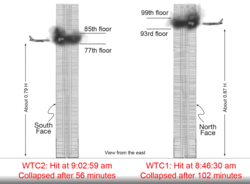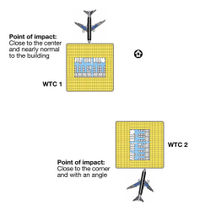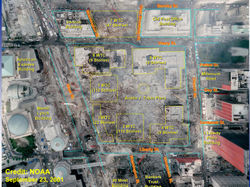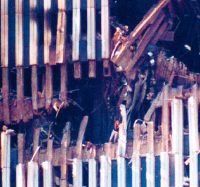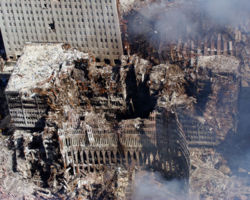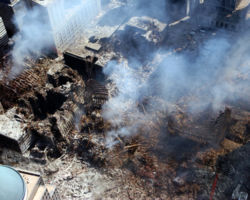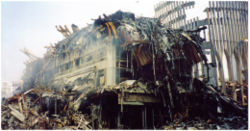Collapse of the World Trade Centre
2007 Schools Wikipedia Selection. Related subjects: Recent History
| Sept. 11, 2001 attacks |
|---|
| Timeline |
| Background history |
| Planning |
| September 11, 2001 |
| Rest of September |
| October |
| Beyond October |
| Victims |
| Survivors |
| Foreign casualties |
| Hijacked airliners |
| American Airlines Flight 11 |
| United Airlines Flight 175 |
| American Airlines Flight 77 |
| United Airlines Flight 93 |
| Sites of destruction |
| World Trade Centre |
| The Pentagon |
| Shanksville, Pennsylvania |
| Effects and aftermath |
| World political effects |
| World economic effects |
| Detentions |
| Airport security |
| Closings and cancellations |
| Audiovisual entertainment |
| Local health |
| Response |
| Government response |
| Rescue and recovery effort |
| Financial assistance |
| Operation Yellow Ribbon |
| Memorials and services |
| Perpetrators |
| Responsibility |
| Organizers |
| Miscellaneous |
| Communication |
| Tower collapse |
| Slogans and terms |
| Conspiracy theories |
| Opportunists |
| Inquiries |
| U.S. Congressional Inquiry |
| 9/11 Commission |
|
|
On September 11, 2001, the two main towers of the World Trade Centre complex were each hit by hijacked commercial aircraft as part of the September 11, 2001 attacks. 2 WTC collapsed to the ground at 9:59 am, less than an hour after being hit, and 1 WTC followed at 10:28 am, causing massive damage to the rest of the complex and nearby buildings. In all, 2,595 people inside and near the towers were killed, along with the 157 people who were aboard the flights.
The Federal Emergency Management Agency (FEMA) issued a performance study of the buildings in May 2002, declaring the WTC design sound and attributing the collapses wholly to extraordinary factors beyond the control of the builders. In its September 2005 report, the National Institute of Standards and Technology (NIST) concurred with this view, noting that the severity of the attacks and the magnitude of the destruction was beyond anything experienced in US cities in the past. It did add, however, that the towers' stairwell design lacked adequate reinforcement.
7 WTC collapsed at 5:20 pm, with no casualties. No conclusive reason for the collapse has ever been established, however NIST's working hypothesis is that the collapse was the result of structural damage sustained during the collapse of Towers 1 and 2, combined with widespread fires in the building.
Construction of 1 and 2 WTC
Structural details
Construction of the towers began in 1968 and was completed in 1970 (1 WTC) and 1972 (2 WTC). 1 and 2 WTC were nearly identical structures. Both had 110 stories, although 1 WTC was 1,368 feet (417.0 meters) tall and 2 WTC was 1,362 feet (415.1 m) tall. 1 WTC also supported a 360 foot tall (110 m) antenna. The core in 1 WTC was oriented with the long axis east to west, while that of 2 WTC was oriented north to south.
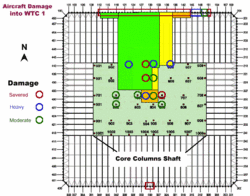
The towers were designed as framed tube structures, with columns grouped around the perimeter and within the core. The perimeter columns supported virtually all lateral loads, such as wind loads, and shared the gravity loads with the core columns. It was said that Live load on those columns could have been increased more than 2,000% before failure occurred. All columns were founded on bedrock, which unlike Midtown Manhattan, where the bedrock is shallow, is at 65 feet below the surface.[ ]
Above the seventh floor there were 59 perimeter columns along each face of the building. The perimeter columns had a square cross section, 14 inches on a side (36 cm), and were constructed of welded steel plate. The thickness of the plates and grade of steel were varied over the height of the tower, ranging from 36 ksi to 100 ksi, with the steel strength and plate thickness decreasing with height. The columns were connected with deep spandrel plates, which were typically 52 inches (1.3 m) deep. The spandrel plates were located at each floor, and served to transmit shear flow between columns, thus allowing them to work together in resisting lateral loads.
The perimeter was assembled from prefabricated modules consisting of three columns and three spandrel plates. The spandrel plates were welded to the columns at the fabrication shop. These modules extended for two full floors and half of two more floors. Adjacent modules were bolted together, with the splices occurring at mid-span of the columns and spandrels. The joints between modules were staggered vertically, so the column splices between adjacent modules were not at the same floor.
The core of each tower was a rectangular area 87 by 135 feet (27 by 41 m) and contained 47 steel columns running from the bedrock to the top of the tower. The columns tapered with height, and consisted of welded box-sections at lower floors and rolled wide-flange sections at upper floors. All of the elevators and stairwells were located in the core.
The large, column-free space between the perimeter and core was bridged by pre-fabricated floor trusses. The trusses had a span of 60 feet (18.2 m) in the long-span areas and 35 feet (11.0 m) in the short span area. The trusses connected to the perimeter at alternate columns, and were therefore on 6 foot 8 inch (2.03 m) centers. The top chords of the trusses were bolted to seats welded to the spandrels on the exterior side and a channel welded to the core columns on the interior side. Approximately 10,000 of the trusses were also connected to the perimeter columns at their bottom chord through viscoelastic dampers to reduce wind-induced sway for occupant comfort. The trusses supported a 4-inch-thick (10 cm) lightweight concrete floor slab, with shear connections for composite action.
The towers also incorporated a "hat truss" or "outrigger truss" located between the 107th and 110th floors. The truss system consisted of six trusses along the long axis of core and four along the short axis. This truss system allowed some load redistribution between the perimeter and core columns and supported the transmission tower.
Design innovations
The WTC towers were innovative in many ways, and were significantly different from earlier generations of skyscrapers such as the Empire State Building. One of the most innovative features is the tube structural system, which allowed large, open floor spaces uninterrupted by columns. This helped maximize the rentable space, and allowed tenants more flexibility in configuring their office space. The towers also made extensive use of pre-fabricated modules such as perimeter sections and floor trusses and extensively used light-weight materials.
The use of express elevators also decreased the amount of space lost to elevator shafts. The express elevators took people to "sky lobbies" on the 44th and 78th floors, where they could board local elevators.
Some of these innovative features have been cited as contributing factors to the collapse. These factors include:
- The large column-free area between the perimeter and core may have allowed the aircraft and the fuel they carried to penetrate deeper into the structure than they would have in a building with a more traditional grid-type column arrangement. This would spread the fire more rapidly through the building, and made damage to the stairwells and the fire proofing of the interior columns more likely.
- A structure with the columns grouped along the perimeter and within the interior core may be inherently less redundant and robust than one with the columns arranged in a grid pattern.
- The WTC used lightweight materials exclusively especially in the facade. Had the facade contained even minimal masonry elements and/or traditional heavy steel outermost column rows, it would have been less likely the aircraft would have cleanly penetrated to the core of each tower— a significant portion of debris and jet fuel would have remained outside, a much different scenario.
- The use of gypsum cladding instead of reinforced concrete to shield stairwells. Almost all skyscrapers, including those built since the WTC, shield stairwells in reinforced concrete. On September 11, it was the collapse of all stairways above the impact level that consigned all people above the impact zone in 1 WTC to death. 2 WTC had two of its three stairwells taken out above the impact area by the plane: some people above the impact zone survived by using the third stairwell. Computer models have shown that most of the stairwells in both towers would likely have remained usable until the general collapse had they been shielded in concrete.
Fireproofing was added after a fire in 1975 that spread to six floors before being extinguished. Early tests conducted on steel beams from the WTC show they generally met or were stronger than design requirements, ruling them out as a contributing cause of the collapse of the towers.
Impacts of airliners
The towers were struck by hijacked Boeing 767 jet planes, American Airlines Flight 11 and United Airlines Flight 175. A typical Boeing 767 is 180 feet (55 m) long and has a wingspan of 156 feet (48 m), with a capacity of up to 24,000 US gallons (91 m³) of jet fuel. The planes hit the towers at very high speeds. Flight 11 was traveling roughly 490 mph (790 km/h) when it crashed into the 1 WTC, the north tower; flight 175 hit 2 WTC, the south tower, at about 590 mph (950 km/h). In addition to severing a significant number of load-bearing columns, the resulting explosions in each tower ignited 10,000 gallons (c. 40 m³) of jet fuel and immediately spread the fire to several different floors while consuming paper, furniture, carpeting, computers, books, walls, framing and other items in all the affected floors.
The buildings had in fact been designed to withstand the impact of the largest airliner of the day, the Boeing 707-320, in the event one was lost in fog while looking to land. The modeled aircraft weighed 263,000 lb (119 metric tons) with a flight speed of 180 mph (290 km/h), as in approach and landing. As energy increases with the square of speed, the 767s that hit the towers had a kinetic energy more than seven times greater than the modeled impact. Nonetheless, the impacts alone did not cause the towers to collapse.
The fires

While the towers were designed to survive aircraft impact, and in fact did survive such impacts, little was known about the fires that might result from them.
According to prevailing theories, it was ultimately the fires that brought the buildings down. The lightness and hollowness of the towers allowed the jet fuel to penetrate far inside the towers, igniting many large fires simultaneously over a wide area of the impacted floors. The fuel from the planes probably burned out in less than ten minutes, but the contents of the buildings burned over the next hour or hour and a half.
It has been suggested that the fires may not have been as centrally positioned, nor as intense, had traditionally heavy high-rise construction been standing in the way of the aircraft. Debris and fuel would likely have remained mostly outside the buildings and/or concentrated in more peripheral areas away from the building cores, which would then not have become unique failure points. In this scenario, the towers might have stood far longer, perhaps indefinitely. The strength of steel drops markedly with heat, losing half its strength at a temperature of 1,202°F (650°C). The heat from the fires quickly began to weaken the central steel columns, the longspan floor trusses, and cross trusses.
Collapse of the two towers
The north tower, 1 WTC, was struck at 8:46 am and collapsed at 10:28 am, standing for 102 minutes after impact. The south tower, 2 WTC, was struck at 9:03 am and collapsed about 56 minutes later, at 9:59 am.
In both cases, the combined effects of the airplane impacts and subsequent fires caused the buildings to collapse. The impacts severed load bearing columns and dislodged fireproofing from the structural steel. Heat from the fires then gradually weakened the structures, causing the floors to sag and the perimeter columns to bow inwards. The towers collapsed abruptly when the perimeter walls finally buckled. Once the collapse was initiated, the enormous weight of the portion of the towers above the impact areas overwhelmed the load bearing capacity of the structures beneath them. As the floors above the impact point were relatively undamaged (save for fire), the upper portion fell as a single unit. The floors did not pancake. Instead, the upper portion stayed whole and smashed through the building like a sledgehammer. The buildings did not collapse: they were pulverized.
Physical features of the collapses
In the case of 1 WTC, it took about 12 seconds to reduce the tower to rubble. NIST, however, also notes that elements of the cores of both buildings remained standing 15-25 seconds after the initiation of collapse (it was difficult to determine the total time of the collapses due to the obscuration of the scene by dust and debris). Both buildings collapsed symmetrically and more or less straight down, though there was some tilting of the tops of the towers. "The building section above came down essentially in free fall ... The falling mass of the building compressed the air ahead of it, much like the action of a piston, forcing material, such as smoke and debris, out the windows." The collapses also spread debris in a wide radius around the buildings, damaging other buildings nearby and producing enormous clouds of dust that covered Manhattan for days. These were composed mainly of pulverized gypsum cladding and dry wall, finely ground concrete from the towers' floors, glass particles, and lead (from the many computers in the buildings).
The collapse mechanism
Owing to differences in the initial impacts, the collapses of the two towers were found to differ in some respects, but in both cases, the same sequence of events apply. After the impacts had severed exterior columns and damaged core columns, the loads on these columns were redistributed. The hat trusses at the top of buildings played a significant role in this redistribution of the loads in the structure.
The impacts also dislodged some of the fireproofing from the steel, increasing its exposure to the heat of the fires. This turned out to be crucial in bringing about the collapses. In the 56 and 102 minutes before the collapse of, respectively, 2 WTC and 1 WTC, the fires, and events associated with them, weakened the core, until it was unable to carry loads. The NIST report provides a useful image of the situation.
| At this point, the core of WTC 1 could be imagined to be in three sections. There was a bottom section below the impact floors that could be thought of as a strong, rigid box, structurally undamaged and at almost normal temperature. There was a top section above the impact and fire floors that was also a heavy, rigid box. In the middle was the third section, partially damaged by the aircraft and weakened by heat from the fires. The core of the top section tried to move downward, but was held up by the hat truss. The hat truss, in turn redistributed the load to the perimeter columns. (p. 29) |
The situation was similar in 2 WTC. In both towers, perimeter columns and floors were also weakened by the heat of the fires, causing the floors to sag and exerting an inward force on exterior walls of the building.
At 9:59 am, the sagging floors finally caused the eastern face of 2 WTC to buckle, transferring its loads back to the failing core through the hat truss and initiating the collapse. At 10:28 the south wall of 1 WTC buckled, with similar consequences. After collapse ensued, the total collapse of the towers was inevitable due to the enormous weight of the towers above the impact areas.
A combination of three factors allowed the north tower to remain standing longer: the region of impact was higher (so the gravity load on the most damaged area was lighter); the speed of the plane was lower (so there was less impact damage); and the affected floors had had their fire proofing partially upgraded.
Early attempts to understand the collapses
Unprecedented
On September 13, 2001, the cover of the New Civil Engineer in the UK consisted of a picture of 1 WTC during its collapse with a single word written across it: "unthinkable". "Just hours earlier, it had been genuinely inconceivable that structures of such magnitude could succumb to this fate."
In subsequent efforts to make sense of the facts, a number of different collapse mechanisms were proposed, culminating in the NIST report of September 2005. Interviewed by the BBC in October 2001, the British architect Bob Halvorson correctly predicted that there would be "a debate about whether or not the World Trade Centre Towers should have collapsed in the way that they did." The autopsy would involve careful analysis of the plans of the WTC, its construction, eye witness testimony, video of the collapses, and examination of the wreckage. Emphasizing the difficulty of the task, Halvorson noted that the collapses were "well beyond realistic experience."
Total collapse
The first scholarly work on the subject has also proved to be the most influential. On Thursday, September 13, Prof. Zdenek P. Bazant of the Department of Civil and Environmental Engineering at Northwestern University submitted a paper providing a 'simple analysis' of the total or 'global' collapse of the building. Bazant found that once the tower was brought to the point of local failure and the upper sections began to fall, the forces involved are an order of magnitude above the ability of the lower structure to withstand:
| the failure of the connections of the floor-carrying trusses to the columns is either accompanied or quickly followed by buckling of the core columns and overall buckling of the framed tube, with the buckles probably spanning the height of many floors (stage 5, at right), and the upper part possibly getting wedged inside an emptied lower part of the framed tube (stage 5, at left). The buckling is initially plastic but quickly leads to fracture in the plastic hinges. The part of building lying beneath is then impacted again by an even larger mass falling with a greater velocity, and the series of impacts and failures then proceeds all the way down (stage 5). |
Other parts of Bazant's paper have since been superseded; notably his assumption that the point of structural failure was reached due "to sustained temperatures apparently exceeding 800°C". However, his analysis of global collapse has been highly influential in later engineering studies, notably for the NIST study, which, relying on Bazant's analysis did not study the reasons for global collapse at all, concentrating only on understanding the events which brought the structure to the point of collapse.
Pancaking floors
Bazant's work inspired the so-called "pancake" collapse theory, which was propounded by Thomas Eagar and popularized by PBS. On this view, when the connections between the floor trusses and the columns broke, the floors fell down, one on top of the other, quickly exceeding the load that any one floor was designed to carry.
While the early efforts had exaggerated the temperatures of the fires, however, Eagar's theory would prove to underestimate the effect of the fires on the structural steel columns. In a paper published in December of 2001, he had focused on the joints between the floor assemblies and the perimeter columns, which, he argued, would be more vulnerable to the effects of the fires. On this assumption he proposed that "the joints on the most severely burned floors gave way, causing the perimeter wall columns to bow outward and the floors above them to fall".
A similar line was taken by Tim Wilkinson, a civil engineer at the University of Sydney. In an "initial suggestion", written already on September 11, he outlined a range of possible effects related mainly to the effects of the fires.
| Eventually, the loss of strength and stiffness of the materials resulting from the fire, combined with the initial impact damage, would have caused a failure of the truss system supporting a floor, or the remaining perimeter columns, or even the internal core, or some combination. Failure of the flooring system would have subsequently allowed the perimeter columns to buckle outwards. Regardless of which of these possibilities actually occurred, it would have resulted in the complete collapse of at least one complete storey at the level of impact. |
Among a series of self-published accounts by structural engineers, HERA structural engineer Charles Clifton emphasized that a combination of factors led to the collapse. Clifton stated that the two towers collapsed in markedly different ways, which led some to suggest that there were two modes of failure. The north tower collapsed directly downwards, seemingly "pancaking" in on itself, while the south tower fell at an angle during which the top 20 or so stories of the building remained intact for the first few seconds of the collapse. Others, like Wilkinson, took these differences to be largely superficial. He argued that the "same mechanism of failure, the combination of impact and subsequent fire damage, is the likely cause of failure of both towers" While NIST did conclude that the collapses varied in their details, they proposed essentially the same "probable collapse sequence" for both towers and rejected "the pancake theory".
The role of the fires
Many identified the fires as the key to the collapses. While NIST would eventually confirm this hypothesis, Thomas Eagar, an MIT materials professor, was nonetheless right to describe the fires as "the most misunderstood part of the WTC collapse". This is because the fires were originally said to have "melted" the floors and columns. As Eagar pointed out, "The temperature of the fire at the WTC was not unusual, and it was most definitely not capable of melting steel." Jet fuel is essentially kerosene and would have served mainly to ignite very large, but not unusually hot, hydrocarbon fires. Nontheless, in 2003, three engineers at the University of Edinburgh, published a paper in which they provisionally concluded that the fires alone (without any damage from the airplanes) could have been enough to bring down the WTC buildings, while noting that 'A complete consensus on any detailed explanation of the definitive causes and mechanisms of the collapse of these structures is well nigh impossible given the enormous uncertainties in key data.' In this view, the towers were uniquely vulnerable to the effects of large fires on several floors at the same time.
Even after the conclusions of the NIST study were public, at least one of these engineers, Jose Torero, is pursuing further research into the potentially catastrophic effects of fire on steel framed buildings. Moreover, when the NIST report was published, Barbara Lane, with the UK engineering firm Arup, criticized its conclusion that the structural damage resulting from the airplane impacts was a necessary factor in causing the collapses.
Core failure
There had also been some visual evidence that the north tower's core had collapsed first: in videos, the large antenna on top of the core can be seen starting downward a fraction of a second earlier than the rest of the building. NIST, however, disputed this claim, stating "that observations from a single vantage point can be misleading and may result in incorrect interpretation. When records from east and west vantage points were viewed, it was apparent that the building section above the impact area tilted to the south as the building collapsed."
Other attempts
Another early attempt, which included many of the elements already noted, came from MIT civil engineers Oral Buyukozturk and Franz-Josef Ulm on September 21, 2001.
| Some 60 tons or more of jet fuel could have easily caused sustained high temperatures of 1,500ºF and higher. Under these conditions, structural steel loses rigidity and strength. The resulting failure of the 2-3 floor system at the site of impact sent the 30 to 25 floors above free-falling onto the 80 to 85 floor structure below. The enormous energy released by this collapse was too large to be absorbed by the structure below. That impact may have ultimately caused the explosive buckling, floor after floor, of the WTC towers. Similar to a car crash in a wall, the towers crashed into the ground with an almost free-fall velocity. |
They would later contribute to an MIT collection of papers on the WTC collapses edited by Eduardo Kausel called The Towers Lost and Beyond, published in May 2002.
According to the NOVA documentary on PBS, "Why the Towers Fell", the core column structure of the south tower was momentarily intact after the floors had collapsed.
Leslie E. Robertson, the lead structural engineer on the team that designed the towers, wrote that "The events of September 11 are not well understood by me . . . and perhaps cannot really be understood by anyone." As NIST would also conclude, however, Robertson conjectured that "the fires raging in the inner reaches of the buildings undermined their strength."
The NIST report
Design of the study
Following pressure from technical experts, industry leaders and families of victims, the Commerce Department's National Institute of Standards and Technology conducted a three year $24 million investigation into the structural failure and progressive collapse of several WTC complex structures. The study included in-house technical expertise and drew upon the knowledge of several outside private institutions for aid to include:
-
- Structural Engineering Institute of the American Society of Civil Engineers ( SEI/ASCE)
- Society of Fire Protection Engineers ( SFPE)
- National Fire Protection Association ( NFPA)
- American Institute of Steel Construction ( AISC)
- Council on Tall Buildings and Urban Habitat ( CTBUH)
- Structural Engineers Association of New York ( SEAoNY)
Scope and limits
The scope of the NIST investigation was limited to "the sequence of events from the instant of aircraft impact to the initiation of collapse for each tower." In line with the concerns of most engineers, NIST focused on the airplane impacts and the spread and effects of the fires, modeling these at a very high level of detail. NIST developed several highly detailed structural models for specific sub-systems such as the floor trusses as well as a global model of the towers as a whole which is less detailed. These models are static or quasi-static, including deformation but not the motion of structural elements after rupture as would dynamic models. So, the NIST models are useful for determining how the collapse was triggered, but do not shed light on events after that point. As stated in the report, it "includes little analysis of the structural behaviour of the tower after the conditions for collapse initiation were reached and collapse became inevitable." (p. xxxvii, fn2) Some engineers have suggested that our understanding of the collapse mechanism could be improved by developing an animated sequence of the collapses based on a global dynamic model, and comparing it with the video evidence of the actual collapses.
The publication of the NIST report did not end all disagreements about the collapses. The trade journal, the New Civil Engineer reported that some still believe that "the towers would have collapsed after a major fire on three floors at once, even with fireproofing in place and without any damage from plane impact." In August of 2006, NIST posted a webpage addressing frequently-asked questions.
7 World Trade Centre
The WTC complex comprised seven buildings, three of which underwent total progressive collapse on September 11, 2001. At 5:20 pm, 7 WTC, a 47-story steel-frame skyscraper across the street from the rest of the complex, became the third building to collapse.
FEMA's provisional study was inconclusive and the collapse of 7 WTC was not included the final report of the NIST investigation into the collapse of the World Trade Centre when it was published in September of 2005. With the exception of a letter to the Journal of Metallurgy, which suggested that some of the structural steel had been exposed to temperatures sufficient to melt it, no studies of the collapse of 7 WTC have been published in scientific journals.
The final report from NIST regarding the collapse of 7 WTC was due in July 2005, but its release date has been postponed. NIST released a progress report in June of 2004 outlining its working hypothesis. On this hypothesis a local failure in a critical column, caused by damage from either fire or falling debris from the collapses of the two towers, progressed first vertically and then horizontally to result in "a disproportionate collapse of the entire structure". In answer to the question of whether "a controlled demolition hypothesis is being considered to explain the collapse", NIST says that it "would like to determine the magnitude of hypothetical blast scenarios that could have led to the structural failure of one or more critical elements." At this point NIST is not committed to any one hypothesis, and new hypotheses may yet emerge.
Remarks by Osama bin Laden
Although its authenticity was questioned, a videotape of Osama bin Laden that was verified by the Pentagon as indicating that Bin Laden, who is a trained Civil Engineer, had not believed that the buildings would collapse completely, but would collapse only above the levels where the planes struck:
| We calculated in advance the number of casualties from the enemy, who would be killed based on the position of the tower. We calculated that the floors that would be hit would be three or four floors. I was the most optimistic of them all. (...Inaudible...) Due to my experience in this field, I was thinking that the fire from the gas in the plane would melt the iron structure of the building and collapse the area where the plane hit and all the floors above it only. This is all that we had hoped for. |
Other buildings
The entire WTC complex was destroyed on September 11, 2001, and many of the surrounding buildings were also either damaged or destroyed as the towers fell. 5 WTC suffered a large fire and a partial collapse of its steel structure.
Other buildings destroyed include St. Nicholas Greek Orthodox Church, Marriott World Trade Centre (Marriott Hotel 3 WTC), South Plaza (4 WTC), and U.S. Customs (6 WTC). The World Financial Centre buildings, 90 West Street, and 130 Cedar Street suffered fires. The Deutsche Bank Building, Verizon, and World Financial Centre 3 suffered impact damage from the towers' collapse, as did 90 West Street. One Liberty Plaza survived structurally intact but sustained surface damage including shattered windows. 30 West Broadway was damaged by the collapse of 7 WTC. The Deutsche Bank Building, known through images of it being covered in a large black 'shroud' after September 11th to cover the building's damage, is currently being deconstructed because of water, mold, and other severe damage caused by the neighboring towers' collapse.
Controlled demolition conspiracy theory
Van Romero, an explosives expert in New Mexico, had seen videos on the day of the attacks and proposed that explosive devices had brought down the buildings. Though he quickly retracted his remarks, the idea has remained in circulation and the rapid collapses of the World Trade Centre buildings has been described as the " grassy knoll" of 9/11 conspiracy theories. Prompted by inquiries from the public, NIST stated in its final report that it "found no corroborating evidence for alternative hypotheses suggesting that the WTC towers were brought down by controlled demolition using explosives planted prior to September 11, 2001." The hypothesis has never been suggested in mainstream engineering scholarship and its proponents are considered "outsiders". In August of 2006, NIST posted a webpage addressing it among other frequently-asked questions.
